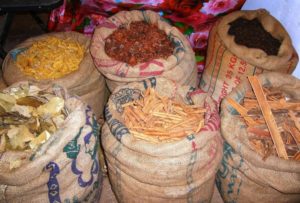Ancient Ayurveda Still One of the Best Answers for Wellbeing

Ayurveda, meaning the science or study of life, is a very complex holistic approach to optimize one’s health and offset diseases and discomfort. Divided into eight branches, similar to the eight branches of yoga, the Ashtangas of Ayurveda include general medicine, pediatrics and OB/GYN, surgery, ENT, toxicology, rejuvenation (geriatrics), aphrodisiacs and psychiatry.
While Ayurveda is not widely understood in our part of the word, in India, the birthplace of Ayurveda, it’s widespread. In Kerala, the state where it may be most prominent, currently 40 percent of health care is Ayurvedic and the local Ayurvedic association has a marketing campaign underway to boost that figure to 50 percent.
The government does its part of support Ayurveda as well. Those of lower socio-economic means in India are entitled to free allopathic or Ayurvedic treatments. Additionally, the Government of India has published formularies for Ayurvedic treatments, available on CDs.
Just as we’ve seen proof of unbelievable scientific intelligence among the ancient Mayas and Egyptians, among other cultures, Ayurveda, over the last 5,000 years has proved its effectiveness based on its age-old wisdom and practices. In the last ten years, blind double tests confirmed the value of Ayurveda. Two plants traditionally used to treat blood pressure were patented by a major pharmaceutical company as allopathic drugs for hypertension. Another Ayurvedic herbal therapy (ephedrine) is now a common allopathic treatment for asthma.

Dr. L. Mahadevan, director of Sri Sarada Ayurvedic Hospital located at the southernmost tip of India, operates a botanical garden and pharmacy alongside his clinic. There are more than 100 herbs cultivated here, many of which can be used for multiple purposes. Among the plants grown in this tropical garden are asiatica, arrowroot, asoka, gooseberries, aloe vera, amaranth, bitter demon, stevia, coriander and neem.
Dr. Mahadevan’s clinic treats about 50 patients a day. He has a staff of 70 which is certainly not the ratio seen in western clinics. While he operates in a fairly remote geographic location, surrounded by paddy fields, lotus ponds and coconut groves. His patients come from all over the world, and most likely seek treatment due to imbalances caused by diet and lifestyle.
According to Dr. Vinod Verma, author of Ayurveda, A Way of Life and founder of the New Way Health Organization in India, “people live lives that are largely anti-life, i.e., our lifestyle is unhealthy…They spend most of their time searching for more money or fame…trapped in a vicious cycle of over medication and its side effects.”
Dr. L. Mahadevan echoed that thought. He says he’s seen patients eat too much and work too much. He says patients nowadays usually prefer the mindless act of taking a pill or a shot, rather than modifying their lifestyle to achieve health and happiness. Some ailments, with Ayurvedic treatment, can be cured merely with water, salt, or exercise. But, in today’s modern world, whether one lives in New Delhi or New York City, there is a too often a focus on the material needs rather than the more important personal needs of each individual.

The Caraka Samhita not only talks about healing techniques, but also the role of the healer. The doctor, it advises, should be “friendly and compassionate toward the sick and should not be greedy.”
Ayurveda focuses on the patient, rather than on the antidote. An Ayurvedic analysis takes much longer than an allopathic one, as the treatment is customized and holistic. As an example of the complexity and holistic nature of Ayurveda, the patient may be advised to modify his or her diet and lifestyle every two months, based on the changing elements of our climate that affects our environment. Likewise, Ayurveda recognizes the daily cycles that alter one’s state of being, which factor into recommended daily regimens.

While most allopathic doctors probably enter the field with a sincere desire to help patients, in today’s American managed care medical environment our medical providers are squeezed so tightly by insurance providers and risk management that these principles are very hard to maintain. Ayurveda, on the other hand, due to its holistic nature, brings about equilibrium in the patients, which results in well being.
Individuality is not a part of western medicine. In Ayurveda, the mind, body and spirituality are all interrelated. In the ancient art and science, health is harmony with the self and the environment.


Deborah,
Thanks for this crash course in Ayurveda… I would love to learn more about it… I might look into the books you mentioned any others you recommend.
Deborah,
Thanks for this crash course in Ayurveda… I would love to learn more about it… I might look into the books you mentioned any others you recommend.
Thanks for sharing the info here. Keep up the good work. All the best.
Thanks for sharing the info here. Keep up the good work. All the best.
I don’t think the title of your article matches the content lol. Just kidding, mainly because I had some doubts after reading the article.
Percentage of drugs prescribed from an essential drug list EDL was calculated to measure the degree to which practices conform to a national drug policy as indicated in the national drug list of Ethiopia generic priligy